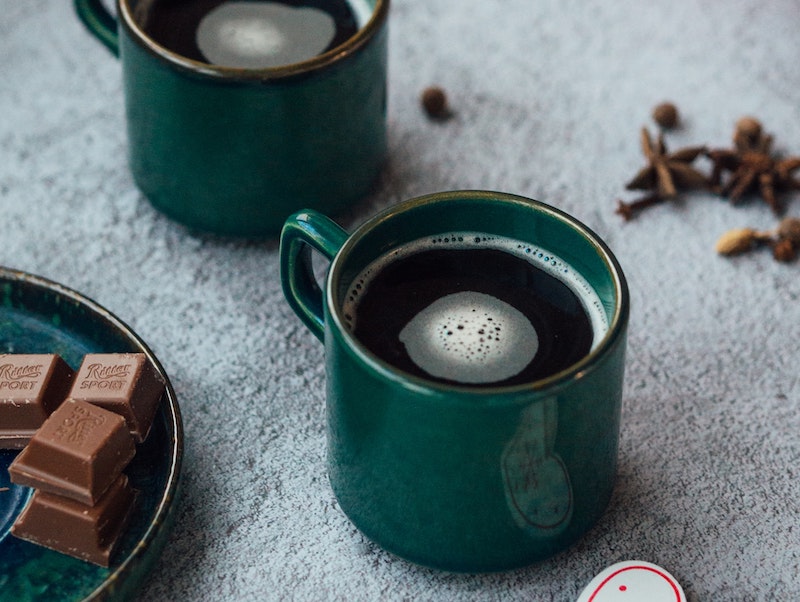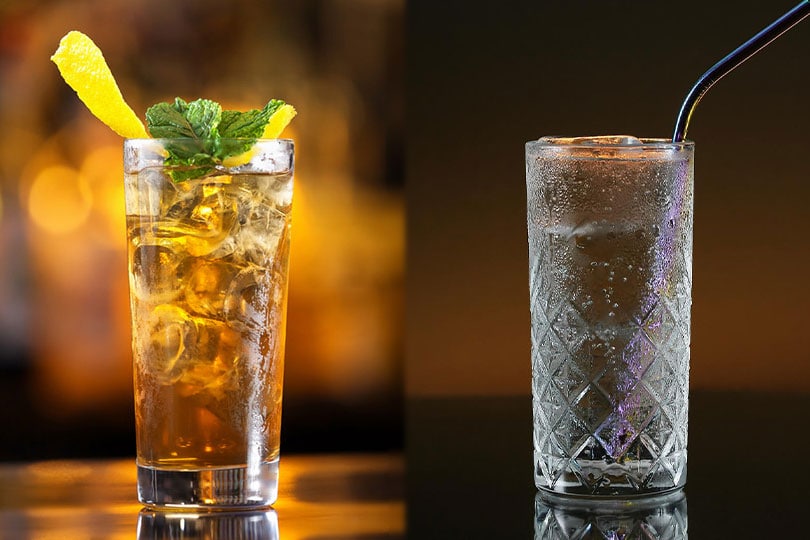
Chocolate and coffee have a lot in common: they are both made with beans that are roasted and ground. No wonder they taste so good together! But you may wonder: when it comes to caffeine in chocolate vs coffee, which one has more?
We’re taking a close look at caffeine in coffee vs chocolate to help you keep an eye on your intake! Should you drink a cup of hot chocolate or brew a pot of coffee? Here’s what you need to know:

Where does the caffeine come from?
Both coffee beans and cacao beans naturally contain caffeine. When you make coffee, you grind up the roasted beans and pour water through them, extracting flavors, oils, and — you guessed it — caffeine! Because you are extracting caffeine, not just eating the whole bean, you’ll end up with a little less caffeine in your cup.

When they’re raw, chocolate beans have a very bitter taste, so they have to be fermented and then roasted. Then the outer shell is removed, leaving cacao nibs that can be ground into cocoa powder. That means that when you eat a chocolate bar, you’re eating the cacao bean itself, so you’re getting all of the caffeine.
These two processes merge when you eat chocolate-covered espresso beans — but that’s a story for another article.
How much caffeine is in chocolate?
The amount of caffeine in chocolate depends on how much cocoa powder is in it. Strong dark chocolate is typically 70 to 85% cacao, regular dark chocolate is 50 to 69%, and milk chocolate is only 10 to 20% cacao. A good rule of thumb? The higher the cacao percentage, the higher the caffeine because the caffeine comes from the cacao bean.

So how much caffeine can you expect in these different types of chocolate? There are about 23 milligrams of caffeine in a 1-ounce square of unsweetened baking chocolate. A larger bar (3.5 ounces) of very dark chocolate (70-85% cacao) has about 80 milligrams. A 3.5-ounce dark chocolate (50-69% cacao) has about 70 milligrams. And a 3.5-ounce bar of milk chocolate has just 20 milligrams of caffeine.
How much caffeine is in coffee?
And what about coffee? There are a lot of factors that can affect how much caffeine is in your cup. The most important of these are your coffee-to-water ratio and your brewing method. If you make strong coffee using more coffee beans, you’ll end up with a higher caffeine level. And if you make espresso instead of brewed coffee, you’ll find more caffeine per ounce.

How much exactly? A single coffee bean contains 6 milligrams of caffeine. A typical 8-ounce cup of coffee has 95 milligrams of caffeine. And a shot of espresso has 64 milligrams of caffeine.

Caffeine in Chocolate vs Coffee: The Bottom Line
So which has more caffeine, chocolate or coffee? It depends a little on what kind of coffee you drink and what type of chocolate you eat.
A very dark chocolate bar has more caffeine than a single shot of espresso, but if you drink a cup of brewed coffee or a double-shot latte, the reverse is true. A cup of brewed coffee has almost five times as much caffeine as a bar of milk chocolate!
The bottom line? If you’re looking for a lot of caffeine, you’re better off drinking a tasty cup of coffee! There’s more caffeine in a cup of brewed coffee than in a chocolate bar.
Looking for more?















